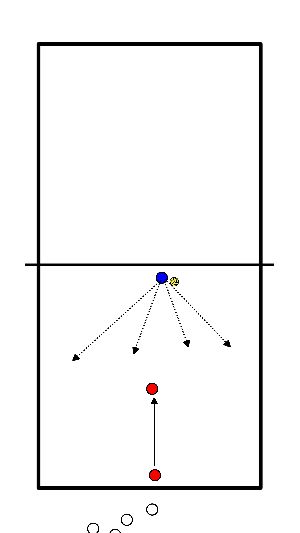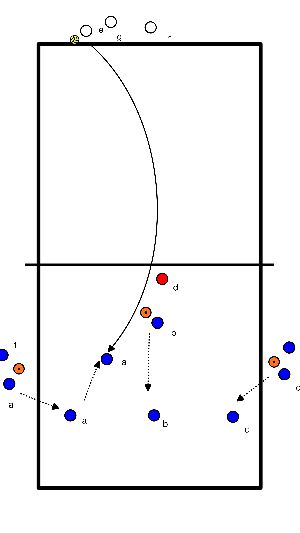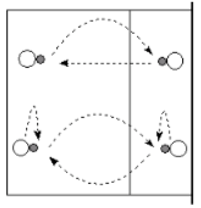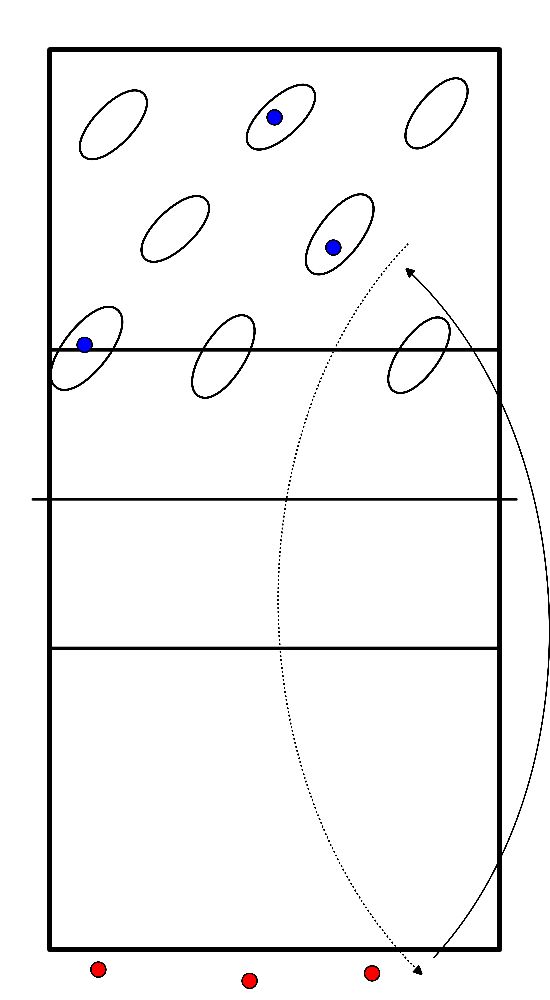Volleyball exercises for u9
- This exercise trains the split step.
- Players line up behind the back line.
- Trainer or player stands at the net.
- One by one the players walk in from the back line.
- When the trainer hits the ball, the player makes a split step.
- Then he gets the ball on a random spot next to or in front of him.
- Player passes back and retrieves ball if necessary.
- After that the player closes in at the back.

- Extension of previous exercise to game situation combination exercise.
- Player a, b and c leave at the pawn
- Player e knocks on the ball (from then on player a, b, c take position in reception) and saves.
- Reception to player d.
- Player d catches touches ball to pos V or pos II.
- On foul serve, players a, b, c lie down on the ground, player g knocks on the ball (and calls ball).
- If player g also misses, trainer throws a free ball.

- Make 3 team, per team 1 ball and 1 bench.
- Benches at equal distance (triangle with 3 teams).
- Teams try to score by bouncing the ball on an opponent's bench each time.
- 1 point each time. Never the same person in a row.
- The teammate defends the bench.
- Which team will have 10 points first?
- Variation:
- No running with the ball (i.e. throwing).
- Exercise to make several quick movements in a row and play high enough.
- Every child stands with the ball one meter from the net.
- Throw the ball over the net with a forearm movement and catch it on the other side.
- Throw the ball over the net with an overhead movement and catch it on the other side.
- Throwing the ball over the net overhead and catching it for yourself at the other side with forearms.
- If necessary, make it more difficult by varying height and distance.
- You have 2 teams one is on one side of the field and the other on the other side.
- There is a ball played in the field the ball may fall on the ground 0/1 time the ball is passed by the teams to the other side of the field.
- If the ball either bounces 1/2 time, goes out or wrong technique a team has a point.
- 4 benches, in pairs to the other side, next pair can as soon as the first bench is free.
- Each pair starts on the other side of the same bench.
- Walk across the bench, pass each other in the middle.
- Walk along the bench, jump in the middle and clap hands together, then the next bench.
- Everybody hops over the bench 4 times with hands on the bench. (move towards each other)
- Each a ball, walk over the bench, pass each other in the middle, while bouncing the ball.
- Bounce the ball, walk along the bench, jump in the middle and clap hands together.
- One ball in pairs, each on one side of the bench.
- Pass the ball while going from right to left (always closer to the middle and then further away again).
- Move sideways.
- Idem one side underarm return.
- Play one side overhead.
Three balls per two players.
- Throw your own ball and catch it again.
- Third ball is tested over and over again
- Same as in jump pass

- Serve in pairs over the net from the (back) line.
- If necessary divide over 2 fields.
- Distribute the hoops on one side of the net.
- Child with ball in serving position, other stands in a hoop on the other side.
- If the ball can be caught without stepping out of the hoop, the hoop is won.
- After each serve change position, until there are no more hoops.
- Which team collects the most hoops?

- Players play two against two.
- Each time the ball is over, they walk over to the other side of the net and join in behind.
- The goal is to keep the ball in play as long as possible.
- If a team makes a mistake, they have to dive to the other side.
Across the field do the following exercises repeat everything 2 times.
- Loose arms in a dribble, forwards and backwards.
- Toes in, toes out.
- Hopping.
- High jump.
- Bounce, make very small skipping movements.
- Knee hugs.
- Lift your knee.
- Lateral knee lifts.
- Hopscotch, fast hopscotch.
- Skater, skating movements.
- Volleyball shuffle, left and right.
- Sumo shuffle, kind of jumping jack but sideways.
- Karaoke, cross passes but the leg that goes in front over the other leg goes up.
- Backwards hip rotation, hip rotation from the inside to the outside and stepping out backwards in a lunge.
- All team members line up and run in circles around the room.
- Every time the trainer blows the whistle, the person in the back must run forward.
- This continues until everyone has run forward once.
- Individual exercise to improve ball feeling with one hand.
- Each player has 1 volleyball, mini volleyball, tennis ball, juggling ball (or for advanced players a non round object; a light plastic container or light bottle for example, but can be used with anything).
- The goal of the players is to keep the ball in the air by hitting it as many times as possible with only one hand.
- Have the players count how many times they can do this per the 2 minutes per task.
- Possible assignments:
- - Underhand lobsmash
- - Over your head
- - Hit your leg afterwards with the hand you played with
- - Clap your hands after touching them
- - Lying down -> sitting -> standing (and back)
- - Raising your knee/heel
- - Against the wall
- - In pairs one player under, the other over the net=
Be creative! = - Possible exercise for several people. (see image)
- One or more in the middle, the rest around it.
- Setters play the ball somewhere around them, the rest have to make sure that the ball is returned to setters in X number of times.
- Agree on how many times the ball can be played.
- Exercise stimulates:
- - Communication
- - Reflexes
- - Ball sense









